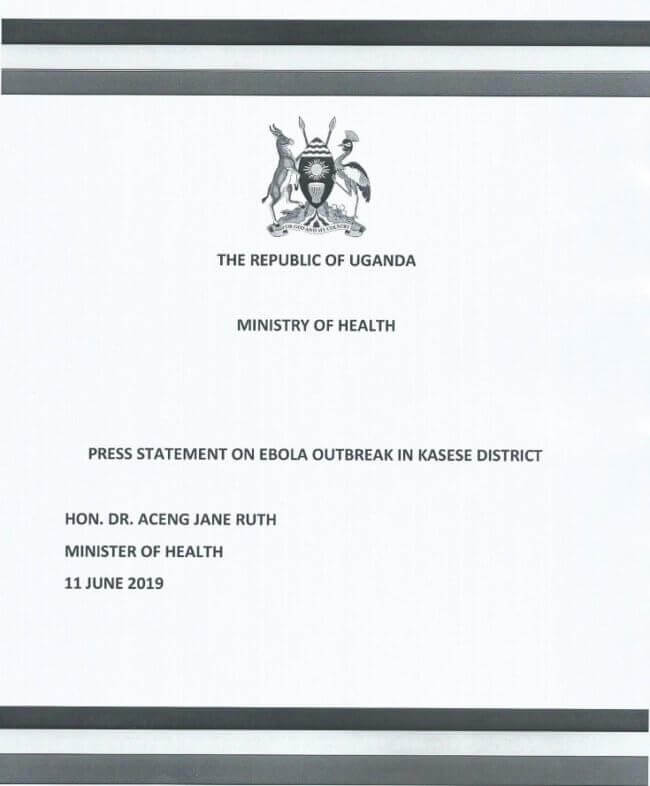There is no threat for tourists traveling currently in Uganda. Future visitors planning a trip to this East African country should yet not consider canceling. A widely published case of Ebola this morning has no direct chance to become a threat to any visitor according to the Uganda Tourism Board. The situation seems to be isolated according to all indications in this case under control. Uganda had been preparing for this for months and vaccinated 4700 health professionals in 165 health centers.
Uganda travel professionals are however under high alert. A known inbound operator told eTN Wednesday morning. “It’s not so good in Uganda after confirmation of an Ebola victim death. The deceased, a child, had crossed over from DR Congo.”
The Uganda Minister of Health Hon. Aceng Jane Ruth and the World Health Organization (WHO) had confirmed a case of Ebola Virus Disease in Uganda on Tuesday and issued a press- statement. After a more major outbreak in the neighboring Democratic Republic of Congo, there have been numerous previous alerts in Uganda, but this is the first confirmed case in Uganda during the Ebola outbreak on-going in the neighboring Democratic Republic of the Congo.
The confirmed case is a 5-year-old child from the Democratic Republic of the Congo who traveled with his family on 9th June 2019. The child and his family entered the country through Bwera Border post and sought medical care at Kagando hospital where health workers identified Ebola as a possible cause of illness. The child was transferred to Bwera Ebola Treatment Unit for management. The confirmation was made today by the Uganda Virus Institute (UVRI). The child is under the care and receiving supportive treatment at Bwera ETU, and contacts are being monitored.
The Ministry of Health and WHO has dispatched a Rapid Response Team to Kasese to identify other people who may be at risk, and ensure they are monitored and provided with care if they also become ill. Uganda has previous experience managing Ebola outbreaks. In preparation for a possible imported case during the current outbreak in DRC, Uganda has vaccinated nearly 4700 health workers in 165 health facilities (including in the facility where the child is being cared for); disease monitoring has been intensified, and health workers trained on recognizing symptoms of the disease. Ebola Treatment Units are in place.
In response to this case, the Ministry is intensifying community education, psychosocial support and will undertake vaccination for those who have come into contact with the patient and at-risk health workers who were not previously vaccinated.
Ebola virus disease is a severe illness that is spread through contact with the body fluids of a person sick with the disease (fluids such as vomit, feces or blood). First symptoms are similar to other diseases and thus require vigilant health and community workers, especially in areas where there is Ebola transmission, to help make a diagnosis. Symptoms can be sudden and include:
- Fever

- Fatigue
- Muscle pain
- Headache
- Sore throat
People who have been in contact with someone with the disease are offered the vaccine and asked to monitor their health for 21 days to ensure they do not become ill as well.
The investigational vaccine being used in DRC and by health and frontline workers in Uganda has so far been effective in protecting people from developing the disease and has helped those who do develop the disease to have a better chance of survival. The Ministry strongly urges those who are identified as contacts to take this protective measure.
Investigational therapeutics and advanced supportive care, along with patients seeking care early once they have symptoms, increase chances of survival.
The Ministry of Health has taken the following actions to contain the spread of the disease in the country:
- The District administration and local councils in the affected area have been directed to ensure that any person with Ebola signs and symptoms in the community is reported to the health workers immediately and provided with advice and testing.
- The Ministry of Health is setting up units in the affected district and at referral hospitals to handle cases if they occur.
- Social mobilization activities are being intensified and education materials are being disseminated.
There are no confirmed cases in any other parts of the country.
The Ministry is working with international partners coordinated by the World Health Organization.
The Ministry of Health appeals to the general public and health workers to work together closely, to be vigilant and support each other in helping anyone with symptoms to receive care quickly. The Ministry will continue to update the general public on progress and new developments.
In the Democratic Republic of Congo, an Ebola crisis is ongoing Dr Mike Ryan, WHO executive director for health emergencies, Rob Holden, who is the incident manager for the Ebola outbreak told media that Ebola cases told media on June 5 that 2,025 cases including 1,357 dead, 552 survivors were confirmed in Congo. Of note is that over the last two weeks they had 88 new cases each week, meaning that in April the average was 126 per week. Numbers have stabilised and in fact, fallen in the last two weeks.
However, there was still substantial transmission in a number of health zones including Butembo and in Mabalako. However, health officials have noted a significant decrease in transmission in Katwa, which was the very hot epicenter of the outbreak not six weeks ago. So, on there was improvements or decreases in transmission and on the other hand, there were areas in which transmission have sustained.
The epidemic currently is affecting 75 health areas in 12 health zones of North Kivu and Ituri and to put that into context, North Kivu and Ituri have 664 health areas in 48 health zones. During this epidemic, 179 health areas have been affected overall and 22 health zones so you will see, with 75 health areas now affected in 12 health zones, it represents a much smaller geographic footprint than we’ve seen previously in the outbreak.
Mabalako is not a city area, it’s a rural area; population density is lower, which is a good thing from a transmission point of view but the downside is distances are longer, communities are in much more rural settings, cases are harder to find, people are harder – it’s much more difficult to bring people to isolation centers and it’s difficult to find everybody that needs to be vaccinated so there are trade-offs here at every stage.























